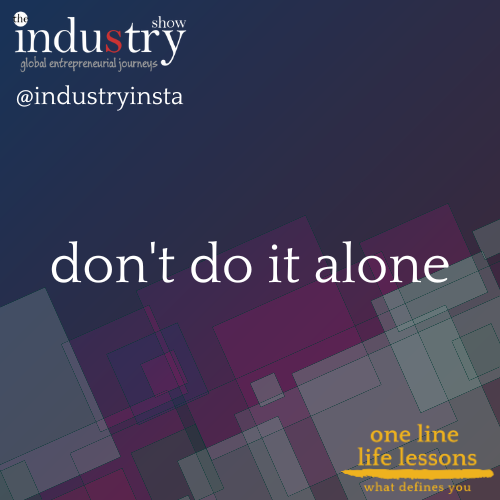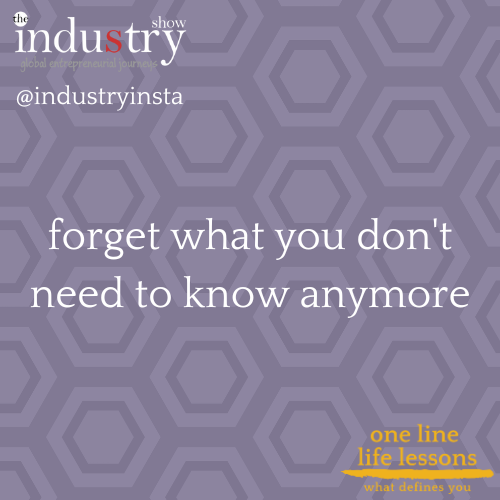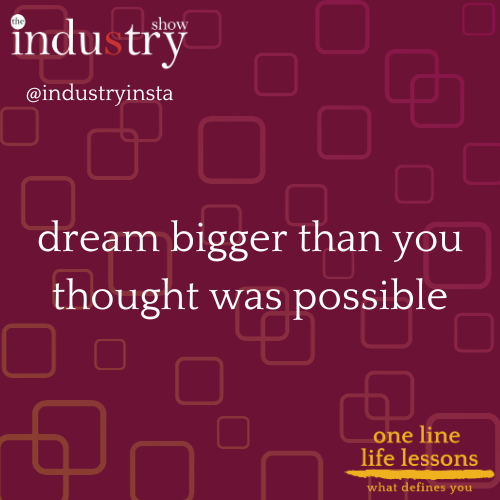Sept 23, 2023
Michael Tringe
Michael Tringe is a seasoned entrepreneur and technology leader with a strong background in the entertainment industry. As the co-founder and CEO of CreatorUp, he has played a pivotal role in revolutionizing the way content is created and distributed in the digital space. Michael is known for his expertise in areas such as video production, online education, and digital marketing, and he has successfully led CreatorUp to become a leading provider of online video production training. Before founding CreatorUp, Michael worked at various entertainment companies, including Lionsgate and Paramount Pictures, where he gained valuable experience in film and television production. Michael holds a Bachelor’s degree in Film and Television Production from the University of Southern California. He is also actively involved in the community and is passionate about using technology to empower creators and storytellers around the world.
One Line Life Lessons from Michael




Episode Highlights
-
(0:00:00) – Nitin Bajaj welcomes Mike Tringe to the show
(0:00:13) – Mike is a filmmaker, a teacher, and an entrepreneur
(0:01:10) – You started creator up to create connections between professionals and companies
(0:02:19) – You have now a network of over 8000 creative professionals globally
(0:04:36) – I would love to hear from you the one big challenge you face
(0:06:21) – Now, on the other side of challenges come opportunities. I’d love to hear from you that one most exciting opportunity
(0:10:18) – Two examples of failures that became lessons for entrepreneurs are shared
(0:13:33) – What do you do to relax when you’re working hard at work
(0:14:21) – Mike shares some of his one line life lessons on the show
Show Transcript
Transcript - Full Episode
Nitin Bajaj: (0:00:00) – Hey everyone, welcome to The INDUStry Show. I’m your host, Nitin Bajaj. And joining me today is Mike Tringe. Mike, welcome on the show.
Micheal Tringe: (0:00:10) – Nice to be here. Thanks for having me.
Nitin Bajaj: (0:00:12) – Great to have you here. Let’s start with who is Mike?
Micheal Tringe: (0:00:17) – Well, I am a filmmaker, I am a teacher. I’m an entrepreneur. I grew up in Nebraska and I have lived as far away as Morocco and China. And I have colleagues and friends all over the world. So I would say I’m a global traveler as well. And I’m inspired by things that are creative and innovative. And my mission, as far as my personal mission is to always keep learning.
Nitin Bajaj: (0:00:52) – That’s awesome. I believe in and I’m a follower of a similar mission. You always got to be a student, you always got to keep it fresh, keep new information coming in because we wake up and we’re a new person every day. So love that. Thanks for sharing. Tell us about this small little company you started called creator up. What’s the mission? What’s the vision? Why do this?
Micheal Tringe: (0:01:20) – Yeah, absolutely. I started creator up to create connections and opportunities for creative workers who may not come from a particularly educated background in terms of formal education or know the right people, but who do have the skills and experience to work. And I believe that creating connections between professionals and companies is important because there’s a lot of red tape at companies in regards to how do you get started working. And so to me, creating a place where people can meet and work together on new projects that inspire them and where they do a good job is a really important part of the creative economy ecosystem.
Nitin Bajaj: (0:02:19) – I love that. Give us a sense for the size and scale of your operations. And what I love to hear most about is the impact you’ve been able to create.
Micheal Tringe: (0:02:33) – Yeah, absolutely. So we are global. We have now a network of over 8000 creative professionals. We have paid out to date, I would say probably somewhere in the range of twelve to $14 million to creative people. I think from my perspective, focused on staffing. As I said, people who may not have had those opportunities otherwise because they may not be working at a big agency or a big production company, et cetera. And there really are so many barriers to be able to find those jobs. So that’s how we get started. In terms of the impact, I think it’s more than the money. I think that it’s about the experience that people are able to gain. I think it’s about the portfolio that they’re able to build. And I think it’s about the connections that they are able to make so really creating an ecosystem where there’s also social capital. And as such, I believe that the impact is exponential, because once you work on a project, that could be the beginning of many projects and that could become a career.
Nitin Bajaj: (0:03:48) – So true. It’s a platform not just for the creators, but also for people who are looking for these people that otherwise they may not have access to. Not everyone. Correct. All sizes and shapes of companies can reach out to bigger entities where they can even afford a lot of this talent.
Micheal Tringe: (0:04:10) – Correct.
Nitin Bajaj: (0:04:11) – I love the ecosystem play here because it’s not just allowing these people that have had no formal education or no formal experience in these domains, but it also democratizes the other end where people like us are able to go access and get access to a lot of this talent that’s out there. So you talked about the reach, the size and the scale. I would love to hear from you the one big challenge you face.
Micheal Tringe: (0:04:50) – Yeah. I mean, in general, I think if you start, let’s start with the problem that we’re solving.
Nitin Bajaj: (0:04:56) – Sure.
Micheal Tringe: (0:04:57) – Because to me, that embodies the challenge. The problem that we’re solving is that if you look at the history of media creation, it’s quite fragmented, whether that be price, whether that be process, whether that be sourcing of talent and or people to do the job. So in that, the question is, well, how can technology begin to streamline that from a workflow perspective for the buyer and create a digital experience that is similar to the types of digital experiences that we’re all used to when it comes to ordering something or overseeing the delivery of something. And then I think you really get a sense of the heart of the challenge, which is how do you take an analog workflow, digitize it, and beyond that, take something as ephemeral and abstract as creativity, and productize that in such a way where you can put a price on it. Right. And so that’s not a tactical challenge, but I think it’s a strategic challenge, and I think it’s a product challenge. And then, of course, there’s many other challenges that come with that. But I’d say that’s maybe one of.
Nitin Bajaj: (0:06:14) – The root challenges, and it’s an evolving one. Sure. Now, on the other side of challenges come opportunities. I’d love to hear from you that one most exciting opportunity that is in front of you.
Micheal Tringe: (0:06:33) – Yeah. I mean, in general, I think the opportunity to become a resource and solution for the creative community and for the industry. And by industry, I mean the buyer to leverage the tools of today more effectively to create content and by tools of today, I’m really referring to the generative AI technology that is out there. We believe that in order for content to be useful and usable, human involvement in that, from setup to oversight to delivery, quality control is essential if your end user is a human. And so as a result, the method of putting humans and machines together in a way that is seamless and valuable to both sides of that ecosystem will be critical to the future of content creation and consumption. For that matter. I think we’re already seeing, as you probably have read, that certain platforms are creating tags for human created content. Lots of policy debates going on around this. So how do we cut through that noise and just look at the positive side of the tools that are out there and how those tools are empowering the creative community to create more and create more interesting types of content.
Nitin Bajaj: (0:08:14) – True. And it’s also at some point, given these technologies, there is also the quantity versus quality aspect that comes in. So how do you take a look at that? How do you, again, looking at a human as a consumer, how do you limit how much is being put out there and what’s the value that’s being driven off of that?
Micheal Tringe: (0:08:36) – Yeah, look, I really think the best analogy that I would like to make here, instead of thinking about this as a conveyor belt or as a factory line where you’re just cranking up the speed on the output, which I think is a poor analogy, rather think about the tool of generative AI as a computer chip. And that computer chip has every, according to Moore’s law, period of time, the ability to increase the output. And that doesn’t necessarily, it’s not always speed, right? Sometimes that processing power. Because why does Pixar create incredible looking films, but also have great story? I mean, the story is the human component, but the looking films, I mean, there’s lots of rate limiting factors according to what makes something as polished as a Pixar film, right? So I’m not saying that putting the generative AI computer chip in the hands of every creator is going to make a Pixar movie. But what I am saying is that for a very long time, tools of technology have been rate limiting factors to creative output. And so now that we’re able to bring that more broadly to communities globally, that to me is incredibly exciting.
Nitin Bajaj: (0:10:07) – It indeed is. Right. And I agree with you, quantity does not mean a lack of quality. It just enables a lot more people to be able to do that all at once. Now, as we look forward, I would love to take a moment and look back in the rear view mirror and ask you to share two instances, one that became a success beyond your imagination, and another one that did not work out as you had expected was a failure and became a lesson. Sure.
Micheal Tringe: (0:10:44) – Yeah. Well, shall we start with the failure? Because those are so much more fun.
Nitin Bajaj: (0:10:49) – Yes. I.
Micheal Tringe: (0:10:54) – Think when I was first starting the company, I believed that I would be capable of just producing quite a lot, of course, content on my own, which I did do to a certain degree. But at the same time, what I realized there was that as much as founders and entrepreneurs want to believe that they can do it all, I was really running up against capacity issues. And that was, of course, influencing things like quality, not just of the delivery of the content, but our ability to just grow the business, run the business. So I think that failure, I would say around failure of overly optimistic, or you might even say egotistical failure to believe that you can do it all and have it be good at the same time. Now, a lot of creators work independently and do a great job of that, but failing to understand the learning curve associated with that growth and that ability to deliver would have been an early failure. I would say success. I mean, success is funny because it sneaks up on you. And we had the opportunity to do a virtual reality live stream for the Special Olympics in 2019.
Nitin Bajaj: (0:12:26) – Nice.
Micheal Tringe: (0:12:27) – Which at the time, we were a really, I’d say early stage company. I don’t know, we had just gotten.
Nitin Bajaj: (0:12:32) – Maybe.
Micheal Tringe: (0:12:37) – That was ESPN level broadcast in terms of the level of quality and having that be delivered both through headsets but also through YouTube. And then what I also found kind of exciting about that is as we were producing this, we had the opportunity to also live stream with mobile phones, the medal ceremonies for all of the athletes, for their parents to be able to see them get a medal if they couldn’t attend in person. And I was like, that might have been the cooler thing. And you never really expect, because for me, media as a mission is communication, and you never really expect some of that long tail value to come to fruition until it does.
Nitin Bajaj: (0:13:30) – That’s really awesome to hear. Now, we talked about work. I’d love to take a step back and ask you, what do you do to reset to just destress or disengage from the day to day hustle of being a CEO, startup founder and what have you? Yeah.
Micheal Tringe: (0:13:53) – Swimming, running and reading. I do a lot of athletic activity to turn my brain off. And then reading is like putting your brain in a washing machine, because once you’re in the book, you’re in the book.
Nitin Bajaj: (0:14:07) – Yeah, love that. And I’m glad you’re able to do that. And hopefully you’re not doing all three together. That’ll make for a.
Micheal Tringe: (0:14:15) – That would be a failure. A failure of execution.
Nitin Bajaj: (0:14:21) – Mike, I would love to transition us into my favorite part of the show, which we call the one line life lessons. I’d love for you to share a few of your life lessons with us in one line. In one line. Yes. That’s the trick.
Micheal Tringe: (0:14:40) – Don’t bite off more than you can chew. Is that a start?
Nitin Bajaj: (0:14:46) – It is.
Micheal Tringe: (0:14:50) – Dream bigger than you thought was possible. Forget what you don’t need to know anymore. And don’t go it alone.
Nitin Bajaj: (0:15:12) – Love that. And when you asked the first one if it was historic, it indeed is. And it also, in many ways conflicts with the whole entrepreneurial culture or aspect of not being able to define that small box that we want to go after. We want to fix it all. We want to boil the ocean. That is a true life lesson that we entrepreneurs need to keep to heart and really define what we want to go after. And sure, as we learn, we want to pivot, we want to change, improve as we learn, but I think that’s a big one. Mike, thanks for sharing your journey and your story. And more importantly, those one line life lessons. We really appreciate it. Congratulations and kudos to you and the team for bringing creator up to where it’s at and really wish you all the luck to many more successes, to being able to bring many more creators to the platform and continuing to grow that community.
Micheal Tringe: (0:16:20) – Thank you so much for having me.
Nitin Bajaj: (0:16:23) – Thank you. The pleasure is ours.



